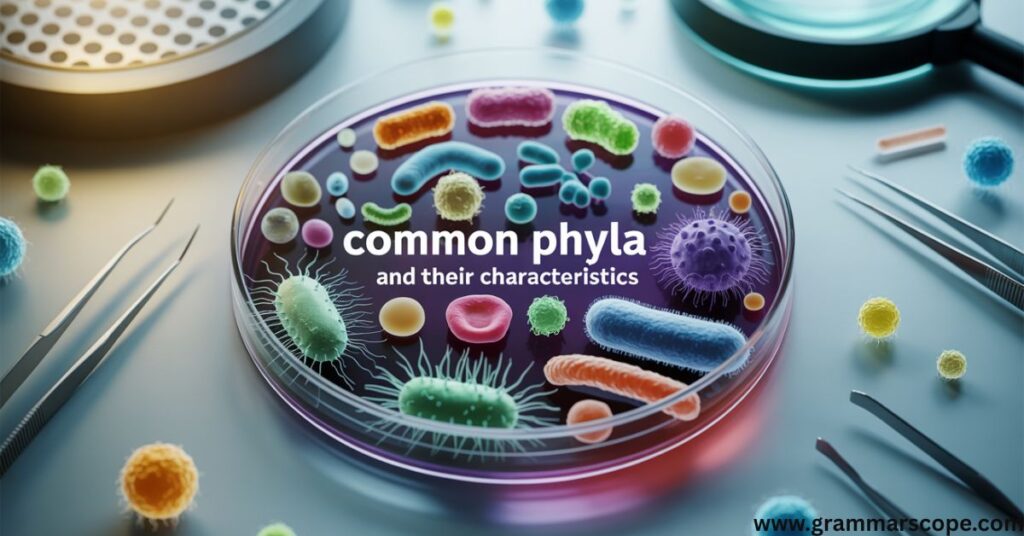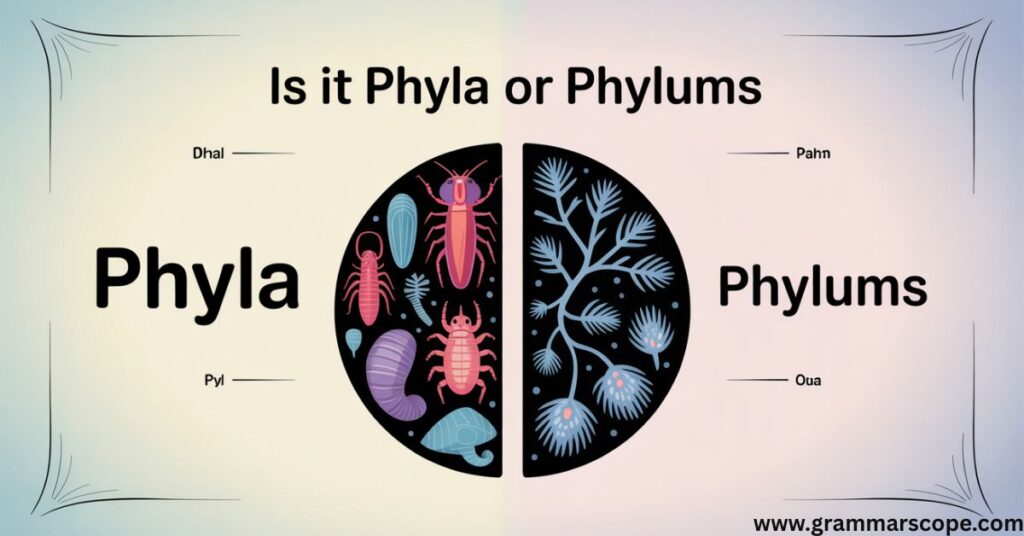Many people get confused when trying to pluralize the word phylum. You might have seen bothIs It Phyla or Phylums used and wondered which one is correct. Understanding the right plural form requires a quick dive into biology, language history, and scientific naming conventions. This article breaks down everything you need to know about the plural of phylum.Ever stumbled on the word phylum and paused, wondering is the plural phyla or phylums? You’re not alone. This tiny grammar twist trips up even science lovers. Let’s clear it up and explore why the right form matters more than you might think.
What Is a Phylum in Biology?

A phylum is a key level in biological classification. It ranks just below kingdom and above class. Scientists use it to group organisms that share major structural and genetic features. Think of phyla as broad categories that help organize the huge variety of living things on Earth.
For example, the phylum Arthropoda includes insects, spiders, and crustaceans all animals with segmented bodies and jointed legs. The phylum Chordata groups animals that have a notochord, such as mammals, birds, and fish. Understanding phyla helps us see the big picture of how life is connected.
In the biological hierarchy, kingdom is the broadest group, followed by phylum, class, order, family, genus, and species. This system helps scientists study and communicate about life more clearly.
Why Does Pluralizing Phylum Confuse People?
English speakers usually add s to make words plural. So, you might expect phylums to be correct. But because phylum comes from Latin and Greek, it follows different rules. The proper plural follows classical Latin endings.
In scientific writing, phyla is the accepted plural. You might see phylums in casual or informal contexts, but it’s not correct in academic or professional settings.
The Origin of the Word “Phylum”
Scientists adopted this term into Latin based scientific language. Latin neuter nouns ending in um usually change to a in the plural form. That’s why phylum becomes phyla.
This Latin and Greek heritage remains in scientific vocabulary because it creates consistency worldwide. Using classical plural forms helps scientists from different languages communicate precisely.
Why Is “Phyla” the Correct Plural of Phylum?

Linguists and biologists agree Is It Phyla or Phylums. This is confirmed by authoritative sources like Merriam Webster and the Oxford English Dictionary. Scientific literature always uses phyla when referring to multiple phylum groups.
On the other hand, phylums is a common mistake made by those unfamiliar with Latin plurals. While it occasionally appears in informal writing, it’s not accepted in scientific or educational contexts.
Latin Plural Rules for Words Ending in “-um”
Most Latin words ending in um form their plurals by changing the ending to a. This applies to many scientific terms. For instance, bacterium becomes bacteria, datum becomes data, and medium becomes media. Sticking to this rule maintains clarity in scientific communication.
While English speakers sometimes add s to these words (like mediums or datums) in casual conversation, formal writing prefers the original Latin plurals.
When Might You See “Phylums”?
Even though phylums is incorrect scientifically, it pops up in informal contexts. Writers who don’t know the Latin rules sometimes use it. However, professional biologists, researchers, and educators avoid phylums.
If you want to write accurately and professionally, always choose phyla.
Using Phylum and Phyla in Sentences
Use phylum when referring to a single group. For example: “The phylum Chordata includes all vertebrate animals.” When talking about multiple groups, say: “Scientists have classified over 30 animal phyla.”
Using phylums in these sentences would sound off to experts and readers familiar with biology.
Why Getting the Plural Right Matters in Science
Precision matters in biology. Scientists need clear language to avoid confusion. Misusing terms like phylums might weaken your credibility or cause misunderstandings, especially when discussing complex biological classifications.
In textbooks, research, and presentations, using phyla shows you understand scientific conventions and communicate clearly.
Common Phyla and Their Characteristics

Some well known phyla include Arthropoda, Chordata, Mollusca, Echinodermata, and Annelida. Each group has unique defining traits.
For instance, Arthropoda features segmented bodies and jointed appendages, Chordata animals have a notochord, Mollusca includes soft bodied animals like snails, and Echinodermata consists of spiny-skinned creatures like starfish.
Knowing these groups illustrates why precise terminology like phyla is important.
Latin Plurals in Other Scientific Terms
Many scientific words borrowed from Latin and Greek follow classical plural rules. Words like cactus become cacti, thesis turns into theses, and phenomenon changes to phenomena. This tradition connects modern science to its linguistic roots.
Why Latin Still Matters in Science
Latin may seem like a language of the past, but in science, it’s very much alive. For centuries, Latin served as the universal language of scholars. Because it no longer evolves, Latin provides consistency that modern languages can’t. That stability makes it perfect for naming organisms, categorizing species, and standardizing terminology in medicine, biology, and other fields.
Common Latin Endings and Their Plural Forms
Scientific terms often follow classical Latin grammar rules, especially when it comes to pluralization. Many words that end in “um” like bacterium or phylum are changed to “-a” in the plural form. So, bacterium becomes bacteria, and phylum becomes phyla. These words follow Latin neuter noun patterns and are used commonly in biology and microbiology.
Words ending in “-us” usually follow a different rule. They turn into “-i” in the plural. For example, fungus becomes fungi, and nucleus becomes nuclei. This rule is especially important in disciplines like medicine and physics, where exact terminology is essential.
Then there are words that end in “-a.” These are generally feminine in Latin and form their plural by becoming “-ae.” You’ll see this with words like larva, which becomes larvae, or formula, which turns into formulae. These are widely used in developmental biology and pharmacology.
Some terms ending in “-is” shift to “-es” in the plural. A good example is analysis, which becomes analyses. Others include diagnosis to diagnoses, and crisis to crises. You’ll often come across these in psychology, diagnostics, and academic research.
Lastly, terms ending in “-ex” or “-ix” follow a pattern where the plural ends in “-ices.” That’s why appendix becomes appendices, and matrix turns into matrices. These forms appear in mathematics, anatomy, and computer science.
Why These Plurals Matter in Scientific Communication
Using the correct plural form isn’t just about sounding formal it helps avoid confusion. When researchers discuss data rather than datums, or nuclei instead of nucleuses, they’re using terminology that the scientific community understands instantly. This shared language improves clarity in papers, experiments, and cross-border collaboration.
In a biology lab, saying that a specimen belongs to different phyla signals that you’re categorizing it across major taxonomic divisions. In a chemistry context, identifying multiple media types means you’re referring to different environments or substances used for growth or reactions not spiritual communicators.
Can You Use Regular English Plurals Instead?

Sometimes, yes. In casual conversations or general writing, modernized English plurals are perfectly acceptable. You might say cactuses instead of cacti, or indexes instead of indices. These forms sound more natural to many English speakers. However, in scientific, medical, or academic settings, traditional Latin plurals are preferred because they’re more precise and universally recognized.
For instance, if you’re writing an academic paper, bacteria will always sound more appropriate than bacteriums. Similarly, in mathematical contexts, using matrices instead of matrixes keeps the language aligned with scholarly standards.
Keeping Scientific Language Consistent
One of the biggest advantages of sticking with Latin plurals is the sense of consistency they bring to science. Across countries, languages, and disciplines, researchers can rely on shared terms like larvae, strata, and alumni. This common vocabulary helps ensure that information is clearly conveyed, whether it’s in a research article or a scientific conference.
Even as science evolves, this classical linguistic structure continues to serve as its backbone. From biology to geology, Latin plurals hold the framework together quietly.
Examples of Latin “-um” Words and Their Plurals
| Singular | Plural | Scientific Context |
|---|---|---|
| Phylum | Phyla | Biological classification |
| Bacterium | Bacteria | Microbiology |
| Datum | Data | Information and statistics |
| Medium | Media | Communication and art |
| Curriculum | Curricula | Education |
Case Study: The Role of Phyla in Evolutionary Biology
In evolutionary biology, phyla help categorize vast diversity. Ernst Haeckel, a pioneer in taxonomy, popularized the concept. Scientists compare genetic data across phyla to trace evolutionary links.
Marine biologists study various marine phyla such as Porifera (sponges) and Cnidaria (jellyfish) to understand ocean life. This example highlights the importance of using phyla when discussing multiple groups.
Pronunciation GuideIs Is It Phyla or Phylums
Phylum is pronounced “FILE um” (/ˈfaɪ.ləm/). The plural phyla sounds like “FILE uh” (/ˈfaɪ.lə/). Correct pronunciation helps in clear communication, especially in teaching and presentations.
Always Use “Phyla” as Is Phyla or Phylums
To wrap up, the plural of phylum is phyla. This form respects Latin grammar and scientific tradition. Avoid using phylums in formal writing or speech.
Phyla are major categories in biology, so using the correct plural form ensures clarity and professionalism. Refer to reliable dictionaries and scientific sources to confirm.
Using phyla correctly signals your understanding of scientific language and improves your credibility. Next time you discuss more than one phylum, confidently say phyla.
Quick Reference: Singular and Plural Forms
| Term | Usage | Context |
|---|---|---|
| Phylum | Singular noun | Refers to one biological group |
| Phyla | Correct plural | Refers to multiple biological groups |
| Phylums | Incorrect plural form | Informal or nonstandard usage |
Frequently Asked Questions: Is It Phyla or Phylums?
What is the correct plural of the word “phylum”?
The correct plural form of phylum is phyla. This follows traditional Latin grammar rules, which are still used in modern scientific terminology. In Latin, many neuter nouns ending in “-um” form their plural by changing that ending to “-a.” That’s exactly what happens here phylum becomes phyla. This form is universally accepted in scientific writing, taxonomy, and education. If you’re referring to more than one phylum in any academic or professional context, phyla is the form you should use.
Is “phylums” ever grammatically acceptable?
The term phylums is not considered correct in standard English or scientific usage. While you might occasionally hear people say it in casual conversation, it’s not grammatically proper. Using phylums instead of phyla in writing especially in biology or science can sound incorrect or unprofessional. In short, phyla is the only accepted plural in biological taxonomy.
Why is the plural “Is It Phyla or Phylums?
This has to do with the word’s Latin roots. In classical Latin, words that end in “-um” are usually neuter nouns. To pluralize these, Latin changes the “-um” ending to “-a.” This pattern carries over into scientific English. That’s why we say bacterium becomes bacteria, stratum becomes strata, and datum becomes data. The same rule applies to phylum, making phyla the correct plural form.
How do I use “phyla” correctly in a sentence?
To use phyla properly, think of it as referring to multiple broad groups within the classification of living organisms. You might say, “Marine biologists study various phyla to better understand aquatic ecosystems,” or “The animal kingdom is divided into several phyla based on shared anatomical traits.” Each sentence uses phyla to describe multiple biological divisions.
Can “phylums” be used informally?
Even in informal writing or speech, phylums still sounds off to those familiar with biology. While some people might say it in conversation without being corrected, it’s not officially accepted in any dictionary or scientific publication. If you’re unsure, always stick with phyla. That’s the form that experts recognize and expect.
What does the word “phylum” actually mean in biology?
In biological classification, a phylum represents one of the highest levels in the taxonomic hierarchy. It sits just below kingdom and above class. A phylum groups organisms that share key structural or developmental characteristics. For example, the phylum Chordata includes all animals with a notochord or spinal column, such as mammals, birds, reptiles, amphibians, and fish. This level of classification helps scientists understand evolutionary relationships and organize the vast diversity of life into meaningful categories.
How many phyla exist in biology?
There are approximately 35 recognized phyla in the animal kingdom, though this number can vary slightly depending on how scientists classify certain organisms. Each phylum represents a unique evolutionary path. Some phyla, like Arthropoda and Mollusca, include incredibly diverse species, while others are more specialized or less commonly encountered. The concept of phyla is essential to grasping the scope and organization of living organisms.
Are there other words like “phylum” that change “-um” to “-a” in plural?
Yes, many scientific terms that originated in Latin follow this same pluralization pattern. For example, bacterium becomes bacteria, datum becomes data, and medium becomes media. Even in general usage, some of these Latin plurals have become commonplace. However, while words like museum have adopted English style plurals like museums, the word phylum still sticks to its Latin roots, making phyla the only correct plural form.
Why is using the correct plural form so important in science?
In scientific writing and discussion, clarity and precision matter. When you use the correct terminology like saying phyla instead of phylums you demonstrate a strong understanding of the subject and a respect for the discipline. It also prevents confusion. Scientists rely on consistent language to share data, discuss findings, and teach new concepts. Using the right plural form helps maintain that consistency and accuracy.
Where does the word “phylum” come from?
It was introduced into modern scientific classification by the German biologist Ernst Haeckel in the 19th century. Haeckel used the term to describe broad categories of organisms that shared basic features, such as body structure or developmental traits. Since then, it has become a central part of biological taxonomy.
Final Thought: Is It Phyla or Phylums
In the world of biology, precision isn’t just helpfu it’s essential. When it comes to the plural of phylum, there’s only one correct form in scientific and academic usage: phyla. While phylums might occasionally appear in casual speech or writing, it lacks the grammatical and scientific validity needed for serious discourse.
Whether you’re a student, educator, researcher, or just curious, using phyla demonstrates both accuracy and respect for the conventions of taxonomy. It’s a small detail, but one that reflects a larger commitment to clear and credible communication in science.Latin plurals in scientific terms isn’t just a fun linguistic exercise it’s a valuable skill for anyone involved in research, writing, or technical communication. While modern English offers more familiar alternatives, the traditional Latin forms still dominate where clarity and consistency are key. Knowing when and how to use them will make your writing more professional, more accurate, and more respected in academic and scientific communities.

Emma Olivia is an experienced blogger and the creative mind behind Grammar Scope. With a passion for language and years of writing expertise, she crafts engaging, informative content that simplifies grammar and writing tips for readers worldwide. Emma’s dedication to clear communication and love for the written word shine through every article she publishes, making Grammar Scope a trusted resource for language enthusiasts and learners alike.







